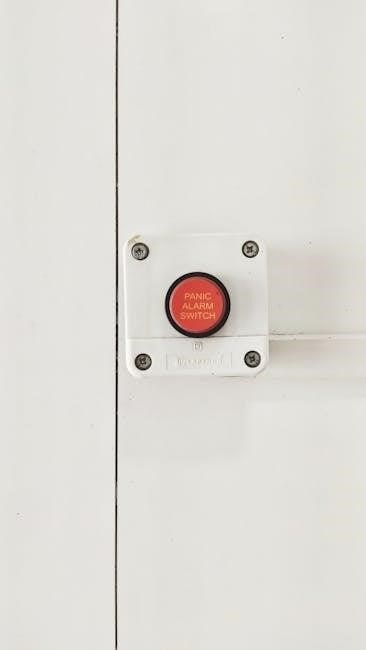Honeywell offers advanced security solutions, with manuals providing essential guidance for installation, operation, and troubleshooting. Their systems, like the VISTA-10P, ensure robust security through innovative features and compliance.
1.1 Overview of Honeywell Alarm Systems
Honeywell alarm systems are renowned for their reliability and advanced security features. Models like the HS331S, HS342S, and VISTA-10P offer comprehensive protection with user-friendly interfaces. These systems integrate sensors, detectors, and control panels to provide real-time monitoring and alerts. They support features such as zone configuration, temporary bypassing, and emergency response protocols. Honeywell systems are designed to meet industry standards and comply with local regulations, ensuring safety and efficiency. The manuals provide detailed guidance on installation, operation, and troubleshooting, making them indispensable for both homeowners and professionals. Whether for residential or commercial use, Honeywell alarm systems deliver robust security solutions tailored to diverse needs.
1.2 Importance of Using a Manual for Honeywell Alarms
A manual is essential for understanding and optimizing Honeywell alarm systems. It provides step-by-step guidance for installation, operation, and troubleshooting, ensuring users can navigate features confidently. The manual details system components, such as control panels and sensors, and explains their functions. It also outlines emergency procedures and maintenance tips, helping users address issues promptly. By following the manual, users can ensure compliance with industry standards and local regulations. Additionally, it serves as a reference for advanced features like custom scenes and remote access. Whether troubleshooting error codes or configuring zones, the manual is a vital resource for maximizing system performance and security. It empowers users to utilize their Honeywell alarms effectively, ensuring safety and efficiency in all situations.

Accessing the Honeywell Alarm Manual
Honeywell alarm manuals are available on Manuals.ca, with models like HS331S and VISTA-10P. Downloading from official sources ensures accurate and reliable guidance for your security system.
2.1 Finding the Correct Manual for Your Honeywell Model
To find the correct manual for your Honeywell alarm system, identify your model number, which is typically located on the device or in the system’s documentation. Visit Manuals.ca, where 8 Honeywell manuals are currently available. Popular models include the Honeywell HS331S, HS342S, and ADEMCO VISTA-10P. The most recently added manual is for the Honeywell RCHW3610WF1001, added on November 22, 2023. Use the search box on Manuals.ca, entering your Honeywell model to locate the specific manual. This ensures you access accurate instructions tailored to your system, covering features, operation, and troubleshooting. Always verify the model number to avoid confusion and ensure compatibility with your security setup.

2.2 Downloading the Manual from Official Sources
To download the Honeywell alarm manual, visit official sources like Manuals.ca or Honeywell’s official website. These platforms offer free access to manuals for various models, including the Honeywell HS331S, HS342S, and ADEMCO VISTA-10P. Ensure your device model is correctly identified to download the correct manual. Official sources provide reliable, up-to-date information, ensuring compatibility and safety. Avoid unauthorized sites to prevent downloading incorrect or malicious content. Honeywell’s official manuals are designed to guide users through system features, troubleshooting, and setup. They also include detailed instructions for advanced functions like scene creation and user management. Always verify the source to ensure authenticity and security for your system.
2.3 Troubleshooting Manual Availability
If you’re having trouble finding your Honeywell alarm manual, ensure you’re using the correct model number. Models like the Honeywell HS331S or ADEMCO VISTA-10P have specific manuals. Check official sources like Manuals.ca or Honeywell’s website for availability. If the manual isn’t listed, verify the model name or search for alternative resources. Some manuals, like the Honeywell RCHW3610WF1001, may require direct requests to customer support. If links are outdated, contact Honeywell’s support team for assistance. Ensure you’re accessing manuals from trusted sources to avoid incorrect or malicious content. Troubleshooting manual availability is crucial for proper system operation and safety. Always confirm the source and model compatibility before downloading.

Understanding Honeywell Alarm System Components

Honeywell alarm systems include control panels, sensors, keypads, and zones. These components work together to provide comprehensive security, ensuring reliable detection and response to potential threats.
3.1 Control Panels and Their Functions
The control panel is the brain of Honeywell alarm systems, managing all security operations. Models like the VISTA-10P and Galaxy 3-48 offer advanced features, including zone configuration, arming/disarming, and integration with sensors. They provide a central interface for monitoring and controlling the entire system, ensuring seamless communication between components. These panels support various security protocols and can be customized to meet specific needs, enhancing home or business protection. Their reliability and functionality make them indispensable for effective security management.
3.2 Sensors and Detectors in Honeywell Alarms
Honeywell alarm systems utilize a wide range of sensors and detectors to ensure comprehensive security. These include motion detectors, door and window sensors, and smoke detectors, all designed to monitor specific areas. Wireless sensors, such as those in the Galaxy 2 Series, offer flexibility and reliability. They communicate seamlessly with the control panel, triggering alerts during breaches or hazards. Advanced features like pet immunity and adjustable sensitivity reduce false alarms. These devices are integral to the system’s effectiveness, providing real-time monitoring and enhancing home or business safety. Proper installation and configuration, as outlined in the manual, ensure optimal performance and reliability.
3.3 Keypads and User Interfaces
Honeywell alarm systems feature intuitive keypads and user interfaces designed for easy operation. These interfaces allow users to arm, disarm, and monitor their systems efficiently. Key pads often include backlit buttons and LCD screens for clear visibility. Advanced models, like the Lynx Touch L7000, offer touchscreen functionality for a modern user experience. Users can input their 4-digit codes to perform actions like bypassing zones or checking system status. The Total Connect 2.0 platform provides remote access, enabling users to control their systems via smartphones or tablets. These interfaces are customizable, allowing users to create scenes or manage access levels. The manual provides step-by-step guidance for programming and using these features effectively, ensuring seamless interaction with the alarm system.
3.4 Zones and Their Configuration
Honeywell alarm systems allow for the configuration of multiple zones, each monitoring specific areas or devices. Zones can be designated as perimeter, interior, or special-purpose areas, such as motion detectors or smoke alarms. The manual provides detailed instructions for setting up and customizing these zones to meet individual security needs. Users can assign unique names to each zone for easy identification. Zone configuration ensures that the system responds appropriately to triggers, such as sounding specific alarms or sending notifications. The manual also explains how to bypass zones temporarily, which is useful for maintenance or when a zone is not in use. Proper zone setup enhances system functionality and ensures reliable security coverage. This feature is essential for tailoring the alarm system to a property’s layout and usage patterns.
Basic Operations of Honeywell Alarms

Honeywell alarms enable arming, disarming, and monitoring through keypads or remote access. Users can bypass zones temporarily and execute emergency procedures, ensuring flexible and reliable security management.
4.1 Arming and Disarming the System
Arming and disarming a Honeywell alarm system is a straightforward process. Enter your 4-digit user code on the keypad, followed by the appropriate command. For arming, press the “Arm” button or use a shortcut like “Away” or “Stay” modes. Disarming requires entering your code and pressing “Disarm.” Zones can be bypassed temporarily by pressing “6” and the zone number. Emergency procedures, such as triggering a panic alarm, are also accessible via designated buttons. Remote access features allow users to arm or disarm the system using a smartphone app. Always refer to your specific model’s manual for detailed instructions, as some systems may vary in operation. Proper arming ensures security, while disarming provides easy access when needed.
4.2 Bypassing Zones Temporarily
Bypassing zones in a Honeywell alarm system allows you to deactivate specific sensors without turning off the entire system. This is useful for maintenance or when authorized access is needed. To bypass a zone, enter your 4-digit user code, press “6,” and then the zone number (e.g., “02” or “11”). The keypad will confirm the zone is bypassed. Multiple zones can be bypassed by repeating the process. Remember to re-arm the system after bypassing to ensure full security. Always refer to your system’s manual for specific instructions, as some models may have variations in the bypass procedure. Properly managing zone bypass ensures your system remains effective while allowing flexibility for temporary adjustments.
4.3 Understanding Emergency Procedures
In emergency situations, Honeywell alarm systems provide clear procedures to ensure safety and prompt response. Upon triggering an alarm, the system alerts monitoring centers and sounds loud sirens. Users should immediately contact authorities if safe to do so. The manual outlines steps for emergency arming and disarming, ensuring quick action. Key features include panic buttons and duress codes for silent alerts. The system also provides voice prompts to guide users through critical situations. Regular drills and familiarization with the manual are essential for effective emergency response. Always prioritize safety and follow the outlined protocols to maximize the system’s protective capabilities during emergencies. Proper training ensures users can act swiftly and confidently when needed.

Troubleshooting Common Issues
Honeywell alarm systems include error codes and reset options to address common issues. False alarms can be resolved by identifying triggers and adjusting sensitivity settings as needed.
5.1 Identifying and Resolving Error Codes
Honeywell alarm systems display error codes to indicate specific issues, guiding users to resolve problems efficiently. For example, “Check 100” often relates to power issues, while “Check 200” may indicate communication failures. Users can refer to the manual for detailed explanations of each code. Regular system checks and tests help identify potential faults before they escalate. If an error persists, resetting the system or consulting the troubleshooting section of the manual can provide solutions. Additionally, updating software and firmware ensures optimal performance and minimizes errors. Always follow the step-by-step instructions in the manual to address error codes effectively and maintain system reliability.
5.2 Addressing False Alarms and Their Causes
False alarms in Honeywell systems often stem from sensor malfunctions, incorrect arming/disarming procedures, or environmental factors like dust or pets. To address this, users should first identify the trigger by checking the system’s event log. Cleaning sensors and adjusting sensitivity settings can resolve many issues. If the problem persists, consulting the manual for troubleshooting steps is essential. Regular maintenance, such as updating firmware and ensuring proper installation, helps minimize false alarms. Additionally, testing the system after adjustments ensures reliability. By following these steps, users can reduce false alarms and maintain a secure, efficient system. Always refer to the manual for model-specific guidance to resolve issues effectively.
5.3 Resetting the Honeywell Alarm System
Resetting a Honeywell alarm system is crucial after false alarms or system errors. Enter your 4-digit user code, then press the reset button or select the reset option from the menu. For some models, like the Lynx Touch L7000, resetting involves pressing and holding the “Home” and “Emergency” buttons simultaneously. Power cycling the system by unplugging it, waiting 30 seconds, and plugging it back in can also resolve issues. Always refer to the manual for specific reset procedures, as methods vary by model. Regular resets help maintain system stability and ensure proper functionality. If issues persist, consult the troubleshooting section or contact Honeywell support for assistance. Resetting ensures your system operates reliably and securely.
Advanced Features of Honeywell Alarms
Honeywell alarms offer innovative features like custom scenes, user management, and smart home integration. Remote access and automation enhance security and convenience, making Honeywell systems top-tier solutions.
6.1 Custom Scenes and Automation
Honeywell alarm systems allow users to create custom scenes, enabling tailored automation for enhanced security and convenience. Through platforms like Total Connect 2.0, users can design scenes that trigger multiple actions with a single command. For instance, a “Goodnight” scene might arm the system, lock doors, and turn off lights. Automation integrates seamlessly with smart home devices, offering personalized control. These features simplify daily routines and improve system efficiency. By leveraging custom scenes, users can optimize their security setup to meet specific needs, ensuring a more responsive and adaptable alarm system. This level of customization enhances overall security and user satisfaction, making Honeywell alarms a versatile choice for modern homes and businesses.
6.2 User Management and Access Levels
Honeywell alarm systems offer robust user management capabilities, allowing administrators to define access levels for different users. This ensures that only authorized individuals can perform specific actions, enhancing security. Users can be assigned unique codes or credentials, with varying levels of access, such as basic arming/disarming or advanced system configuration. The system also supports temporary access for guests or service personnel, which can be revoked easily. These features promote flexibility while maintaining strict control over system operations. By managing user access effectively, Honeywell alarms provide a secure and customizable solution for homes and businesses, ensuring that sensitive functions remain protected from unauthorized use.
6.3 Integration with Smart Home Systems
Honeywell alarm systems seamlessly integrate with popular smart home platforms, enhancing convenience and control. Compatibility with systems like Samsung SmartThings and Amazon Alexa allows voice commands for arming, disarming, and status checks. Users can also automate scenes, linking alarm actions to other smart devices, such as lighting or thermostats, for a unified home experience. This integration enables real-time monitoring and custom notifications, ensuring a connected and secure environment. By merging security with smart home technology, Honeywell systems offer a modern, efficient solution for homeowners seeking advanced control and peace of mind. This feature-rich integration is detailed in Honeywell manuals, guiding users through setup and optimization for a tailored smart home security system.
6.4 Remote Access and Monitoring
Honeywell alarm systems offer robust remote access and monitoring capabilities through platforms like Total Connect 2.0. Users can arm, disarm, and monitor their systems from anywhere using smartphones or tablets. Real-time notifications alert homeowners to security breaches, system errors, or motion detection. Remote monitoring also allows users to check sensor statuses, view event histories, and receive custom notifications. This feature enhances security by enabling immediate responses to incidents, even when away from home. Integration with smart home systems further extends these capabilities, providing a seamless and connected security experience. Honeywell manuals detail how to set up and utilize remote access, ensuring users can maximize their system’s potential for enhanced safety and convenience.
Maintenance and Upkeep
Regular system checks, battery replacements, and software updates are crucial for optimal performance. Honeywell manuals provide detailed guidance on maintaining and updating your alarm system effectively.
7.1 Regular System Checks and Tests

Regular system checks and tests are essential to ensure your Honeywell alarm system operates efficiently. These checks involve verifying sensor functionality, keypad responsiveness, and system connectivity. The manual provides step-by-step instructions for testing zones, ensuring all components communicate properly with the control panel. Additionally, it recommends periodic inspections of batteries, wiring, and hardware to prevent malfunctions. Scheduling routine tests helps identify and address potential issues before they escalate, ensuring continuous security and reliability. By following the manual’s guidelines, users can maintain their system’s performance and extend its lifespan. Regular maintenance also ensures compliance with industry standards and local regulations, providing peace of mind and optimal protection.
7.2 Replacing Batteries and Hardware Components
Replacing batteries and hardware components in your Honeywell alarm system is crucial for maintaining reliability. The manual provides clear instructions for identifying when replacements are needed, such as low battery warnings or faulty sensors. It recommends using Honeywell-approved batteries and components to ensure compatibility and performance. Regular battery replacements, typically every 3-5 years, prevent system failures during critical moments. Hardware components like sensors or keypads may need replacement due to wear or damage. The manual guides users through safe removal and installation processes, minimizing downtime and ensuring proper system functionality. Always refer to the manual for specific part numbers and replacement procedures to avoid using non-approved devices, which could compromise system integrity and safety. Timely replacements enhance overall system efficiency and user confidence.
7.3 Updating Software and Firmware
Regular software and firmware updates are essential to ensure your Honeywell alarm system operates at peak performance. The manual provides detailed steps for checking and installing updates, often available through Honeywell’s Total Connect 2.0 platform or official websites. Updates may enhance security features, fix bugs, or add new functionalities. Users are advised to only download updates from authorized sources to prevent system corruption. The manual also outlines how to verify the update’s success and troubleshoot common issues during the process. Keeping your system updated ensures compatibility with the latest technologies and maintains optimal security. Always follow the manual’s instructions to avoid errors and ensure a smooth update experience. Regular updates are critical for maintaining system reliability and performance.

Safety and Compliance

Honeywell alarm systems comply with industry standards and regulations, ensuring reliable security solutions. Adherence to installation best practices and local codes guarantees optimal performance and user safety.
8.1 Industry Standards for Alarm Systems
Honeywell alarm systems are designed to meet rigorous industry standards, ensuring reliability and effectiveness. Compliance with standards like UL (Underwriters Laboratories) and EN (European Norms) guarantees system performance. These standards cover aspects such as false alarm reduction, response times, and equipment durability. Honeywell’s adherence to these norms ensures that their systems are trusted for residential and commercial security. Regular updates and certifications further enhance compliance, providing users with peace of mind. By aligning with industry benchmarks, Honeywell systems maintain high levels of safety and functionality, making them a preferred choice for security solutions worldwide.
8.2 Best Practices for System Installation
Proper installation of Honeywell alarm systems is crucial for optimal performance. Always follow the manufacturer’s guidelines and industry standards. Begin by assessing the property to determine the best placement for sensors and control panels. Ensure all components are installed securely and wired correctly to avoid interference. Test each device thoroughly after installation to confirm functionality. Regularly update software and firmware to maintain system efficiency. Adhere to local regulations and safety codes to ensure compliance. Consider consulting certified professionals for complex setups. Proper installation ensures reliability, reduces false alarms, and maximizes security. Refer to the manual for specific instructions tailored to your Honeywell model for a seamless setup experience.
8.3 Compliance with Local Regulations
Ensuring compliance with local regulations is essential when installing and operating Honeywell alarm systems. Honeywell designs its products to meet industry standards and legal requirements, but specific local laws may vary. Familiarize yourself with regional regulations regarding alarm systems, such as false alarm penalties or mandatory features like low-frequency sounders. For instance, the Honeywell Galaxy 3-48 panel complies with European standards, while other models may adhere to U.S. or international codes. Always verify that your system meets local fire and security codes. Refer to the manual for guidance on configuring settings to align with legal requirements. Compliance ensures system legitimacy, avoids penalties, and guarantees reliable performance. Check with local authorities or certified professionals to confirm adherence to all applicable regulations.
Honeywell alarm systems offer comprehensive security solutions, supported by detailed manuals. Their guides ensure ease of use, troubleshooting, and access to advanced features, making Honeywell a trusted choice for safety and efficiency.
9.1 Summary of Key Points
Honeywell alarm systems are renowned for their reliability and advanced features, with manuals providing comprehensive guidance for users. These manuals cover installation, operation, and troubleshooting, ensuring optimal system performance. Key points include the importance of using approved devices, understanding error codes, and regular maintenance. The manuals also detail how to access and download guides for specific models, such as the VISTA-10P and Galaxy 3-48. Troubleshooting sections address common issues like false alarms and system resets. Additionally, the manuals emphasize compliance with industry standards and best practices for installation. By following the guidelines, users can maximize their system’s efficiency and security, making Honeywell a trusted choice for home and commercial safety.
9.2 Final Tips for Effective Use of Honeywell Alarms
To maximize the effectiveness of your Honeywell alarm system, always refer to the manual for model-specific guidance. Regularly test and maintain your system to ensure optimal performance. Familiarize yourself with error codes and troubleshooting steps to address issues promptly. Explore advanced features like custom scenes and remote access for enhanced security. Keep your system updated with the latest software and firmware. For complex configurations, consult official Honeywell resources or certified professionals. By following these tips, you can ensure your Honeywell alarm system provides reliable protection and peace of mind. Always prioritize compliance with local regulations and industry standards for optimal functionality and safety.
